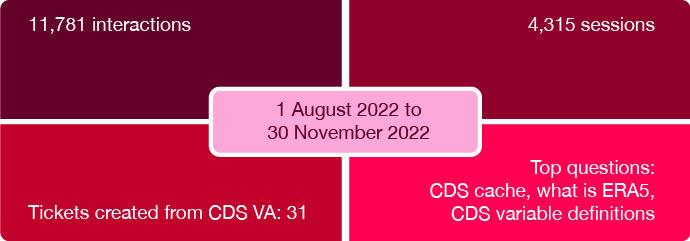The Climate Data Store (CDS) of the EU’s Copernicus Climate Change Service (C3S) run by ECMWF now has over 165,000 users and provides a wealth of climate data and information. The aim of the CDS Virtual Assistant (VA) is to help users find the answers they need as simply, quickly and efficiently as possible. The VA, or ‘Knowledge Duck’, was first released on the CDS on 1 July 2021. It has now been extensively improved to enhance its capabilities.

The user support journey and the Knowledge Duck
Various support channels are available for C3S users. These include the VA, the Knowledge Base, the User Forum, and the Jira-based service desk. These form the basis of the user support journey which was implemented in early 2022. The aim of this is to promote user self-help and direct users who are looking for information. At the end of the journey, users are still able to contact the Support team if direct assistance is needed. As shown in the user support journey figure, the VA is the first step in this process.

The VA is accessed via the Knowledge Duck icon on the CDS web interface. Here, users can type in a question, and the VA will respond with answers drawn from various information sources. These include the ECMWF parameter database and existing documentation stored on the CDS itself.
During the first six months of operation, the Data Support Team monitored user interactions and improved the responses provided. In particular, cases where conversations led to negative feedback, or the VA was unable to answer/understand (‘dead ends’), were identified and addressed as quickly as possible. It was also seen that the questions asked by users rapidly increased in complexity over time, with more free-text questions being asked. These were challenging for the VA to understand and respond to correctly. These issues formed the basis for a short project undertaken by an external contractor and managed by Data Support.
The project ended in July 2022 and delivered several improvements, many of which go beyond what the previous version of the VA provided:
- A significant reduction in the likelihood of conversation ‘dead ends’
- The introduction of structured flows (‘guided conversations’) to direct users through the content of the CDS and C3S products and services. This allows users to ‘click through’ to find answers to common questions
- The CDS VA interface was redesigned, to improve the look and feel so that information is more accessible to users
- Better variables and improved spatial and temporal searching; pseudonyms, locations and specific years can now be searched for, and spelling mistakes are handled in a much better way. Users are also able to filter the results of a dataset search by a number of facets, such as variable and product type
- The ability for a user to raise a Support Jira ticket directly from the VA interface. In this case, the user is prompted to enter their email address and the details of their question. If the user is not registered with ECMWF, they are prompted to register. Once it has been confirmed that the user has a valid ECMWF account, they can enter the details of their question, and a Jira ticket is automatically created. The user is provided with a link to the query, so they can follow progress
- The ability for users to leave a feedback comment, which is then sent to the relevant user support team
- Multimedia (e.g. videos) can now be incorporated into VA responses
- The way feedback is managed has been simplified, so that a more agile service can be provided
- Behind the scenes, the VA backend was redesigned so that it now uses Botpress (https://botpress.com), which allows complex conversational flows to be implemented.
Taken together, the recent improvements to the VA mean that it is now a very capable starting point for the user support journey.

Outlook
In its first year, the VA has proved a valuable addition to the user support channels available, and the backend developments have made it more straightforward to manage and extend. In addition, we are considering having a support person behind the service for specific periods each week, who could either interact with users directly or provide a customised response in a live user conversation. It is anticipated that VAs will also be used for the Atmosphere Data Store (ADS) of the EU’s Copernicus Atmosphere Monitoring Service (CAMS) implemented by ECMWF – and ultimately the merged Climate and Atmosphere Data Store – as well as for other ECMWF systems to complement existing user support services.
The VA is an efficient and powerful way to bring information to users. With more users attracted to our data and services, our support function needs to scale up. In this way, we will be able to continue to deliver a high-quality support service to more and more users. We look forward to the continuing development of the VA over the coming years.
You can access the CDS and the Knowledge Duck at: https://cds.climate.copernicus.eu.
